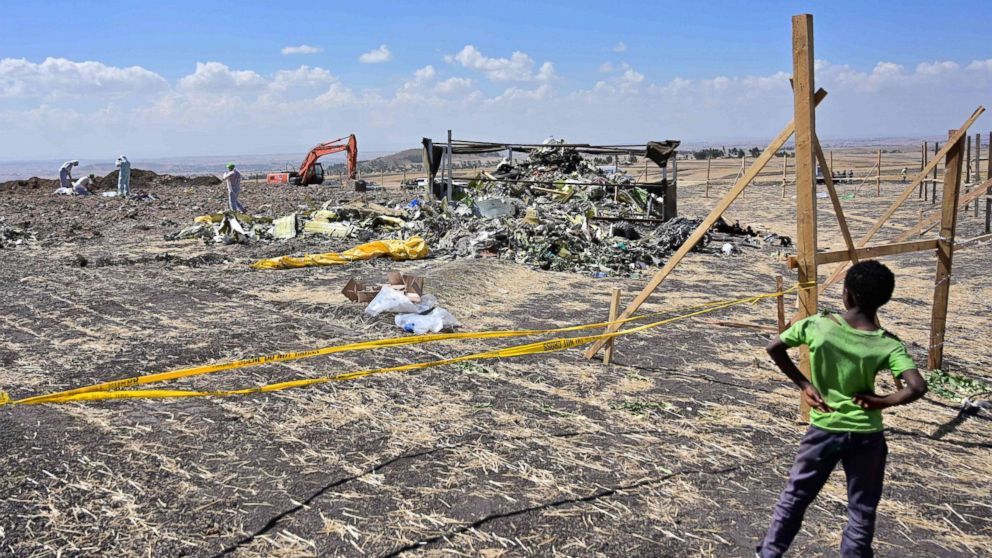
The Ethiopian Airlines crew commanding the Boeing 737 Max 8, which crashed last month and killed all 157 people on board, followed all recommended procedures but couldn't regain control of the doomed flight, Ethiopian investigators told reporters Thursday morning.
Ethiopian Transport Minister Dagmawit Moges said preliminary findings from an investigation into the deadly crash show the aircraft had a valid certificate of airworthiness, the pilots were licensed and qualified to conduct the flight, and the plane's takeoff appeared to be "very normal." As the jet began nose diving, the pilots "repeatedly" performed all emergency procedures provided by Boeing, the manufacturer, but they "were not able to control the aircraft," Moges told reporters at a press conference in Ethiopia's capital, Addis Ababa.
Ethiopian Airlines Flight 302 went down in clear weather in the morning on March 10, six minutes after taking off from Addis Ababa Bole International Airport. The American-made jet, carrying 149 passengers and 8 crew members, was headed to Nairobi, Kenya.
Based on the initial report, Ethiopian safety investigators recommend Boeing reviews the aircraft flight control system of its new 737 Max 8 model and that avian authorities verify the flight controllability has been adequately addressed by the manufacturer before resuming operations of this aircraft, according to the transport minister.
Two aviation sources familiar with the probe told ABC News on Wednesday that the Ethiopian Airlines flight suffered a damaged angle-of-attack sensor upon takeoff from a bird or foreign object, triggering erroneous data and the activation an anti-stall system -- called MCAS -- sending the pitch of the plane downward and ultimately crashing into the ground.
According to the sources, the pilots did not try to electronically pull the nose of the plane up before following Boeing's emergency procedures of disengaging power to the horizontal stabilizer on the rear of the aircraft. One source told ABC News they manually attempted to bring the nose of the plane back up by using the trim wheel. Soon after, the pilots restored power to the horizontal stabilizer.
With power restored, the MCAS was re-engaged, the sources said, and the pilots were unable to regain control before the crash.
Boeing said a statement on Wednesday: "We urge caution against speculating and drawing conclusions on the findings prior to the release of the flight data and the preliminary report."
The Chicago-based aircraft manufacturer has supplied more than 370 Boeing 737 Max 8 jets to 47 airlines since the model debuted in May 2017, and 72 of them are currently flying in the United States, according to Boeing.
French and American investigators are assisting in the Ethiopian probe and at the center of it is an automated anti-stall safety system on the Max and its possible link to issues in the Ethiopian flight and a Lion Air crash in 2018.
In both crashes, the Boeing 737 Max aircraft struggled to maintain a steady flight path. The planes repeatedly lost and gained altitude before entering a dive to the earth's surface. In the two incidents, a new anti-stall safety system on the Max that controls trim -- MCAS -- was activated, sources have told ABC News.
Commercial airline pilots are trained to disengage the system in the event of runaway trim, when the airplane is making unexpected pitch movements. It's unknown what would have kept the pilots of the Lion Air flight from disengaging the system and trimming the aircraft. Lion Air has defended the training of its pilots.
In the days following the crash of Ethiopian Airlines Flight 302, airlines and aviation authorities around the world grounded the Max. The United States was the last to do so on March 13, after the Federal Aviation Administration concluded the refined satellite data that became available to the agency that day warranted a temporary grounding of the Max.
Last week, the acting FAA administrator went to Capitol Hill to defend the government's response to the two crashes. Daniel Elwell told senators on Wednesday that while the FAA may have been among the last aviation regulators in the world to ground the Max, it and Canada were the first to make a decision based on robust data from the aircraft.
Boeing says it is working a software update for the automated safety system and it is expected to be approved by the FAA and offered to airline in a few weeks.
https://abcnews.go.com/International/damaged-sensor-ethiopian-airlines-737-max-triggered-fatal/story?id=62139860
2019-04-04 09:22:30Z
CBMicGh0dHBzOi8vYWJjbmV3cy5nby5jb20vSW50ZXJuYXRpb25hbC9kYW1hZ2VkLXNlbnNvci1ldGhpb3BpYW4tYWlybGluZXMtNzM3LW1heC10cmlnZ2VyZWQtZmF0YWwvc3Rvcnk_aWQ9NjIxMzk4NjDSAXRodHRwczovL2FiY25ld3MuZ28uY29tL2FtcC9JbnRlcm5hdGlvbmFsL2RhbWFnZWQtc2Vuc29yLWV0aGlvcGlhbi1haXJsaW5lcy03MzctbWF4LXRyaWdnZXJlZC1mYXRhbC9zdG9yeT9pZD02MjEzOTg2MA


